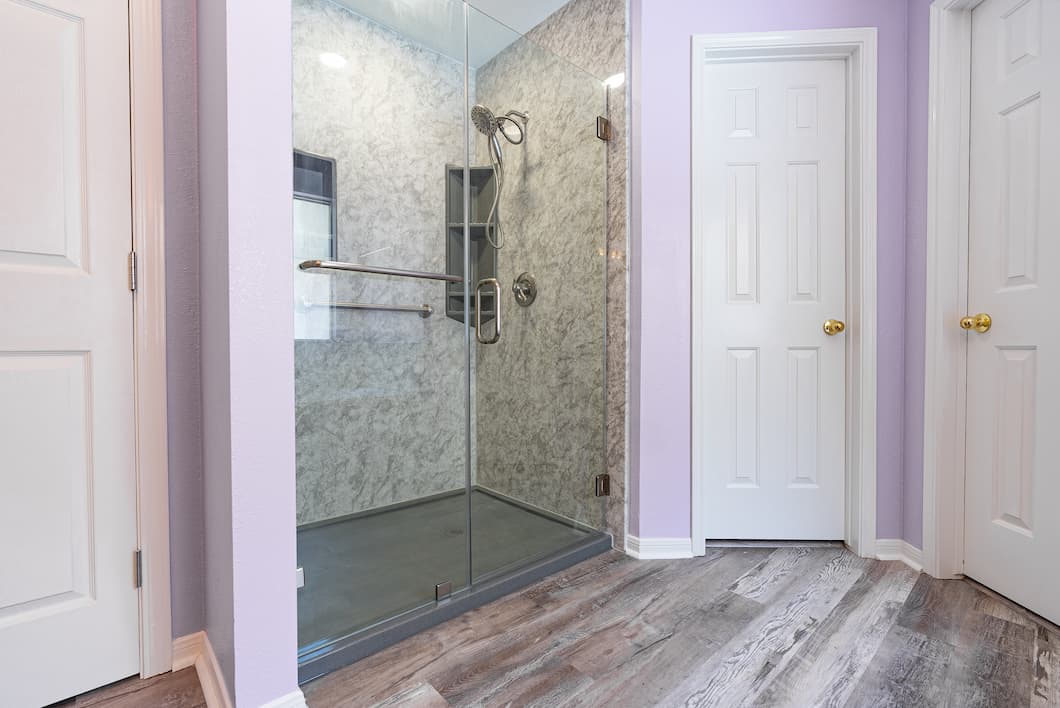Jun 28, 2025
Shower Door Cleaning Steps
In Cleaning

Maintaining a clean home is important for your health and happiness—especially in the shower, where soap, minerals, and steam team up to leave spots and haze on glass. Below is a simple, safe routine for crystal-clear shower doors, plus the only cleaning recipes and products you really need.
Safety first: never mix household chemicals. In particular, do not mix bleach with ammonia or acids (like vinegar or lemon), or vinegar with hydrogen peroxide. If you combine solutions, do so purposefully and in separate steps—never in the same bottle. Label sprays clearly and ventilate while cleaning.
How to clean your shower door (step-by-step)
- Pick one cleaner (store-bought or homemade).
Look for non-abrasive, glass-safe formulas. Avoid gritty powders and harsh acids that can scratch or etch glass or damage protective coatings. - Pre-spray from top to bottom.
Use a spray bottle to coat the glass evenly, especially edges and hardware where buildup hides. - Let it dwell.
Give the cleaner time to work: 10–15 minutes for most glass cleaners; up to 20–30 minutes for light hard-water deposits. Don’t let acids dry on the glass. - Agitate gently.
Use a non-scratch sponge or microfiber. Avoid scouring pads/steel wool. For stubborn spots, a plastic razor scraper held flat can help (wet the area first). - Rinse thoroughly.
Rinse with warm water (a handheld shower is ideal). A final splash with distilled water reduces spotting in hard-water areas. - Dry and polish.
Pull a squeegee top-to-bottom, then finish edges/handles with a dry microfiber. This prevents water spots and keeps glass clear.
Effective, glass-safe cleaning recipes
- Everyday glass spray (alcohol based): 1 cup water + 1 cup isopropyl alcohol (70%) + 1–2 drops dish soap. Streak-free and fast-drying.
- Soap-scum fighter (mild alkaline): 2 cups warm water + 1 tbsp liquid dish soap + 1 tbsp baking soda. Shake gently; rinse well.
- Hard-water helper (acidic): 1:1 white vinegar and water. Do not use vinegar on natural stone (marble, limestone, travertine); it can etch. Rinse thoroughly and don’t let it dry on glass.
Important mixing notes: Don’t mix bleach with anything but plain water. Don’t mix vinegar with hydrogen peroxide (forms peracetic acid). Vinegar + baking soda isn’t toxic, but it neutralizes cleaning power and can pressurize a closed bottle—avoid bottling that combo.
Weekly & daily routines that keep glass spotless
- Daily (30 seconds): After each shower, squeegee glass and wipe hardware/edges with a microfiber.
- 2–3× per week: Quick spray with your everyday glass cleaner; wipe dry.
- Weekly deep clean: Use the soap-scum or vinegar solution (stone-safe areas only). Rinse and dry thoroughly.
- Ventilation: Run the bath fan during and 20 minutes after showers to reduce humidity (mold’s best friend).
Tools & products that make it easy
- Squeegee with hook (keep it in the shower).
- Two microfibers: one damp for cleaning, one dry for polish.
- Plastic razor scraper for mineral spots (used gently on wet glass).
- Protective coatings: If your door has a factory coating (e.g., ShowerGuard or similar), use only manufacturer-approved cleaners to preserve the warranty. We offer spot-resist coatings on new glass—ask during your design consult.
Troubleshooting specific problems
- Hard-water spots: Dwell time is key. Apply the vinegar solution (stone-safe areas only), keep wet with a damp cloth for 10–15 minutes, then gently scrub and rinse. Repeat rather than scrubbing aggressively.
- Cloudy haze after cleaning: Often residue. Rinse more thoroughly and finish with an alcohol-based glass spray + dry microfiber.
- Mold at seals/tracks: Spray hydrogen peroxide (3%) on silicone/tracks; let sit 10 minutes; wipe and dry. Improve ventilation and keep these areas dry after showers.
What to avoid
- Abrasive powders, scouring pads, and magic erasers on coated glass (can dull or scratch).
- Leaving acidic cleaners (vinegar/lemon) to dry on glass or anywhere near natural stone.
- Mixing chemicals (especially bleach + ammonia or bleach + acids).
Need a low-maintenance upgrade?
If you’re tired of fighting grout and mineral spots, consider solid surface walls and spot-resist coated glass during your next shower remodel. These systems minimize seams and clean in minutes.
FAQ: Shower Door Cleaning
Q: What’s the best homemade cleaner for daily use?
A: A 1:1 mix of water and 70% isopropyl alcohol with a drop of dish soap is streak-free and fast-drying.
Q: Can I use vinegar on all shower doors?
A: Use vinegar only on glass and non-stone surrounds. Never use acids on natural stone (marble, limestone, travertine)—they can etch.
Q: How do I remove hard-water spots without scratching?
A: Apply the vinegar solution (stone-safe areas) and keep it wet 10–15 minutes. Gently agitate, rinse, and dry. Repeat as needed; don’t use abrasives.
Q: Is ammonia safe on glass?
A: Dilute ammonia can clean glass, but ventilate well and never mix with bleach or other products. Many prefer alcohol-based sprays for lower odor.
Q: How often should I deep clean?
A: With daily squeegeeing, a weekly deep clean is enough for most homes. Hard-water areas may need an extra mid-week wipe.